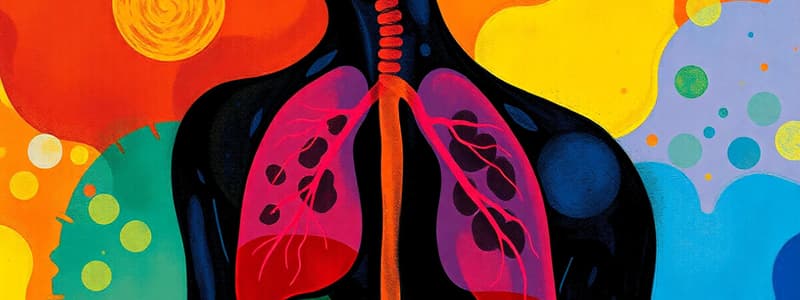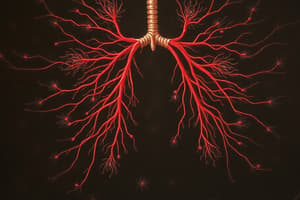Podcast
Questions and Answers
What is human biology?
What is human biology?
The study of human anatomy, physiology, and how humans interact with their environment.
List the seven characteristics of life and provide an example of each.
List the seven characteristics of life and provide an example of each.
Different Chemistry (DNA, proteins), Energy Use (Cellular respiration converts glucose into ATP), Cellular Composition (All living things are made of cells), Homeostasis (Body temperature regulation), Response to Environment (Plants grow towards sunlight), Growth & Reproduction (Cells divide), Evolution (Populations change over generations).
What is homeostasis, and why is it important?
What is homeostasis, and why is it important?
Homeostasis is the maintenance of stable internal conditions (e.g., body temperature). It ensures proper function and survival.
How do organisms use energy, and what process generates it?
How do organisms use energy, and what process generates it?
What are the three domains of life, and how do they differ?
What are the three domains of life, and how do they differ?
What are the four defining features of humans?
What are the four defining features of humans?
Define science and describe how it applies to human biology.
Define science and describe how it applies to human biology.
What is the scientific method and its key steps?
What is the scientific method and its key steps?
What is a hypothesis, and how does it differ from a theory?
What is a hypothesis, and how does it differ from a theory?
What is peer review, and why is it important?
What is peer review, and why is it important?
Explain the difference between prokaryotic and eukaryotic cells.
Explain the difference between prokaryotic and eukaryotic cells.
What is a population, and how does it relate to biological hierarchy?
What is a population, and how does it relate to biological hierarchy?
What are the levels of biological hierarchy from smallest to largest?
What are the levels of biological hierarchy from smallest to largest?
Who was Robert Hooke, and why is he significant?
Who was Robert Hooke, and why is he significant?
Define DNA and explain its role.
Define DNA and explain its role.
What is an experimental group, and how does it differ from a control group?
What is an experimental group, and how does it differ from a control group?
What is matter?
What is matter?
What are elements, and how are they different from compounds?
What are elements, and how are they different from compounds?
What are the three subatomic particles and their charges?
What are the three subatomic particles and their charges?
What is the atomic number of an atom?
What is the atomic number of an atom?
What is an isotope?
What is an isotope?
What are ionic and covalent bonds?
What are ionic and covalent bonds?
What is pH, and what does the scale measure?
What is pH, and what does the scale measure?
What are the four macromolecules of life?
What are the four macromolecules of life?
What is the primary function of carbohydrates?
What is the primary function of carbohydrates?
What is the primary function of lipids?
What is the primary function of lipids?
What are the three principles of cell theory?
What are the three principles of cell theory?
What is the function of the plasma membrane?
What is the function of the plasma membrane?
What is the role of the nucleus?
What is the role of the nucleus?
What are ribosomes responsible for?
What are ribosomes responsible for?
What does the mitochondria do?
What does the mitochondria do?
What is the difference between rough and smooth ER?
What is the difference between rough and smooth ER?
What does the Golgi apparatus do?
What does the Golgi apparatus do?
What is diffusion?
What is diffusion?
What is osmosis?
What is osmosis?
What happens to a cell in a hypertonic solution?
What happens to a cell in a hypertonic solution?
What are the four stages of cellular respiration?
What are the four stages of cellular respiration?
Where does glycolysis occur?
Where does glycolysis occur?
How much ATP does cellular respiration produce?
How much ATP does cellular respiration produce?
What happens in anaerobic respiration?
What happens in anaerobic respiration?
Flashcards
Human Biology
Human Biology
Study of human anatomy, physiology, and interaction with the environment.
Different Chemistry
Different Chemistry
Living things contain unique molecules like DNA and proteins.
Energy Use
Energy Use
Using energy, e.g., cellular respiration converts glucose into ATP.
Cellular Composition
Cellular Composition
Signup and view all the flashcards
Homeostasis
Homeostasis
Signup and view all the flashcards
Response to Environment
Response to Environment
Signup and view all the flashcards
Growth & Reproduction
Growth & Reproduction
Signup and view all the flashcards
Evolution
Evolution
Signup and view all the flashcards
Homeostasis
Homeostasis
Signup and view all the flashcards
Cellular Respiration
Cellular Respiration
Signup and view all the flashcards
Three Domains of Life
Three Domains of Life
Signup and view all the flashcards
Defining Features of Humans
Defining Features of Humans
Signup and view all the flashcards
Science
Science
Signup and view all the flashcards
Scientific Method Steps
Scientific Method Steps
Signup and view all the flashcards
Hypothesis
Hypothesis
Signup and view all the flashcards
Theory
Theory
Signup and view all the flashcards
Peer Review
Peer Review
Signup and view all the flashcards
Prokaryotic Cell
Prokaryotic Cell
Signup and view all the flashcards
Eukaryotic Cell
Eukaryotic Cell
Signup and view all the flashcards
Population
Population
Signup and view all the flashcards
Biological Hierarchy
Biological Hierarchy
Signup and view all the flashcards
Robert Hooke
Robert Hooke
Signup and view all the flashcards
DNA
DNA
Signup and view all the flashcards
Experimental Group
Experimental Group
Signup and view all the flashcards
Control Group
Control Group
Signup and view all the flashcards
Matter
Matter
Signup and view all the flashcards
Elements
Elements
Signup and view all the flashcards
Compounds
Compounds
Signup and view all the flashcards
Subatomic Particles
Subatomic Particles
Signup and view all the flashcards
Ionic Bond
Ionic Bond
Signup and view all the flashcards
Study Notes
- Here are your study notes
Human Biology
- The study of human anatomy, physiology, and interactions with the environment.
Seven Characteristics of Life
- Different Chemistry: Living organisms have unique molecules like DNA and proteins.
- Energy Use: Cellular respiration converts glucose into ATP.
- Cellular Composition: All living things are made of cells.
- Homeostasis: Regulation of body temperature is an example.
- Response to Environment: Plants growing towards sunlight.
- Growth & Reproduction: Cells dividing and organisms reproducing.
- Evolution: Populations changing over generations.
Homeostasis
- It is the maintenance of stable internal conditions like body temperature.
- Ensures proper bodily function and survival.
Energy Usage in Organisms
- Organisms convert food into ATP using cellular respiration for energy.
Three Domains of Life
- Archaea: Primitive, prokaryotic, and found in extreme environments.
- Bacteria: Prokaryotic, found in common environments.
- Eukarya: Eukaryotic, includes plants, animals, fungi, and protists.
Four Defining Features of Humans
- Bipedalism: Ability to walk upright.
- Opposable thumbs.
- Large brains.
- Complex language.
Science
- It is the study of the natural world through observation and experimentation.
- Human biology applies scientific methods to study human life.
Scientific Method
- Observation → Hypothesis → Experiment → Data Collection → Conclusion → Peer Review.
Hypothesis vs. Theory
- A hypothesis is a testable prediction.
- A theory is a well-tested explanation supported by evidence.
Peer Review
- Ensures scientific findings are valid and reliable before publication.
Prokaryotic vs. Eukaryotic Cells
- Prokaryotic: No nucleus, simple (e.g., bacteria).
- Eukaryotic: Has a nucleus, complex (e.g., humans, plants).
Population
- A group of the same species in an area.
- Important for understanding the biological hierarchy from individuals to ecosystems.
Levels of Biological Hierarchy
- Atom → Molecule → Cell → Tissue → Organ → Organ System → Organism → Population → Community → Ecosystem → Biosphere.
Robert Hooke
- Discovered cells using a microscope in 1665.
DNA
- Carries genetic information for inheritance and cell function.
Experimental vs. Control Group
- Experimental group: Receives the variable being tested.
- Control group: Does not receive the variable; used for comparison.
Matter
- Anything that has mass and occupies space.
Elements vs. Compounds
- Elements: Pure substances with one type of atom (e.g., oxygen).
- Compounds: Contain two or more elements (e.g., H2O).
Subatomic Particles
- Protons (+), Neutrons (neutral), Electrons (-).
Atomic Number
- The number of protons in an atom's nucleus.
Isotope
- An atom of the same element with a different number of neutrons.
Ionic vs. Covalent Bonds
- Ionic bonds: Transfer of electrons (e.g., NaCl).
- Covalent bonds: Sharing of electrons (e.g., H2O).
pH Scale
- Measures the concentration of H+ ions.
- 0-6 is acidic, 7 is neutral, 8-14 is basic.
Four Macromolecules of Life
- Carbohydrates, Lipids, Proteins, Nucleic Acids.
Primary Function of Carbohydrates
- Provide energy (e.g., glucose).
Primary Function of Lipids
- Long-term energy storage, insulation.
Cell Theory Principles
- All living things are made of cells.
- Cells are the basic unit of life.
- All cells come from pre-existing cells.
Plasma Membrane Function
- Regulates what enters and exits the cell.
Role of the Nucleus
- Contains DNA and controls cell activities.
Ribosomes
- Responsible for synthesizing proteins.
Mitochondria
- Produces ATP via cellular respiration.
Rough ER vs. Smooth ER
- Rough ER: Has ribosomes and makes proteins.
- Smooth ER: No ribosomes and makes lipids.
Golgi Apparatus
- Modifies, packages, and ships proteins.
Diffusion
- Movement of molecules from high to low concentration.
Osmosis
- Diffusion of water across a membrane.
Cell in Hypertonic Solution
- It shrinks due to water loss.
Cell in Hypotonic Solution
- It swells and may burst due to water intake.
Four Stages of Cellular Respiration
- Glycolysis, Preparatory Step, Citric Acid Cycle, Electron Transport Chain.
Glycolysis Location
- Occurs in the cytoplasm.
ATP Production in Cellular Respiration
- Around 36 ATP per glucose molecule.
Anaerobic Respiration
- Only 2 ATP produced.
- Lactic acid builds up.
Studying That Suits You
Use AI to generate personalized quizzes and flashcards to suit your learning preferences.
Related Documents
Description
Overview of human biology, focusing on anatomy, physiology, and environmental interactions. Explains the seven characteristics of life, including unique chemistry, energy use(ATP), cellular composition, homeostasis, and responses to the environment.




